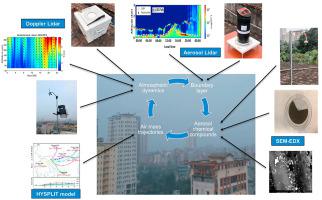Atmospheric Pollution Research ( IF 3.9 ) Pub Date : 2021-05-01 , DOI: 10.1016/j.apr.2021.101068 Bao Anh Phung Ngoc , Hervé Delbarre , Karine Deboudt , Elsa Dieudonné , Dien Nguyen Tran , Son Le Thanh , Jacques Pelon , François Ravetta

|
With the aim of identifying key factors explaining the severe pollution events that occur under the impact of the Northeast monsoon during the winter period in Hanoi, a two-month campaign was carried out (11 January to 22 March 2019). The local meteorological parameters and the origin of the air masses were investigated, notably using a Doppler Lidar, and the structure of the boundary layer was thoroughly studied using elastic Lidar measurements for the first time in Hanoi. Four heavily polluted events occurred during the campaign, which were associated with hazy days; the highest daily PM2.5 concentrations reached ~130 μg m−3 while the mean concentration during the campaign was 45 ± 25 μg m−3. These severe polluted events in Hanoi were mainly related to LRT coming from China besides local emission or LRT from other polluted regions of Vietnam. BLH proved to be one of the key factors controlling air pollution in Hanoi. Indeed, the elastic Lidar measurements showed that the daily maximum of the hourly BLH varied from 700m to 1200m during cloudy days, while it was always below 1000m during hazy days. The lower BLH on the hazy days weakened the vertical mixing and was directly related to an increase in aerosol concentrations at the surface.











































 京公网安备 11010802027423号
京公网安备 11010802027423号